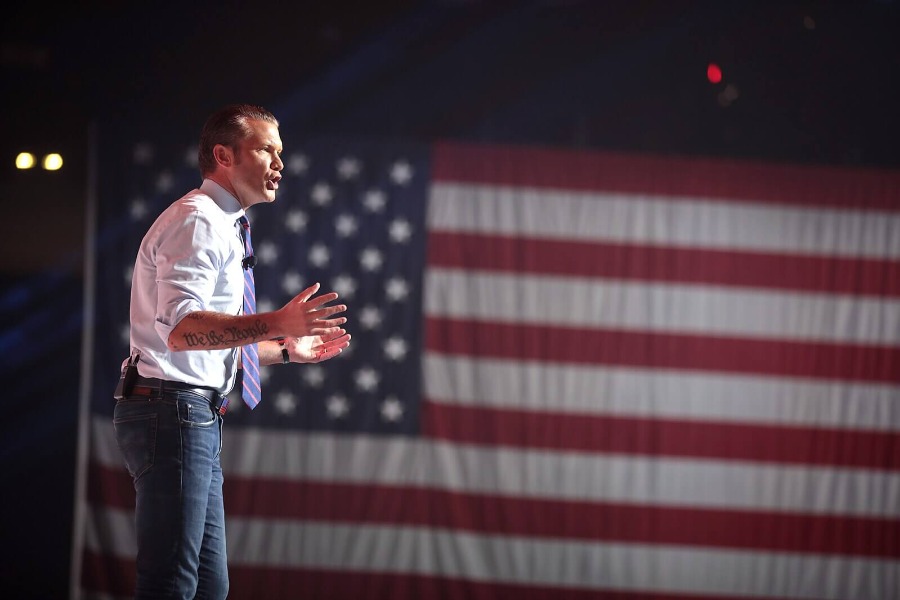Will the Bureaucracy Save Us from the President?
Published by The Lawfare Institute
in Cooperation With

There has been a lot of talk on this blog and elsewhere over just how panicked we should be at the prospect of a Trump presidency, and over whether and how the incoming administration might be reined in. One frequently-expressed hope is that the vast executive branch bureaucracy—which in even normal times operates as a hurdle to presidential action—might perhaps save us from the worst of Trump’s promised abuses. In the short term, the bureaucracy will surely slow him down and impede some of his plans. But intra-executive branch forces are not enough to protect against executive overreach; in fact, over time, they expand and entrench presidential claims to power.
We can’t know everything about how Trump Administration will interact with the laws and norms that serve as checks on executive power. But recent history holds clues as to how the forces of the executive branch pressure presidential decisionmaking. Drawing on that history, my short answers to these questions about panic are not especially comforting:
- Yes, we should be worried (contra Jack).
- We already should have been worried (contra Ben); and
- We should be concerned not only with the next 4-8 years, but, assuming we survive those, we might reasonably be even more concerned with the post-Trump future of executive power.
I recently posted a piece, The Obama War Powers Legacy and the Internal Forces That Entrench Executive Power, that grapples with the role that norms and mechanisms inside the executive branch play in advancing and protecting executive claims to power. I explore these executive branch forces through the lens of recent history (this piece is part of an AJIL “agora” on the Obama war powers legacy). But there are lessons in that history and the transition from Bush to Obama not only for the transition to the incoming Trump administration, but also (perhaps even more so) for what will come next.
Inside the executive branch exist powerful norms and decision-making mechanisms that favor continuity and hinder presidents from effecting change. But there are also powerful internal forces that tilt the executive branch toward the incremental aggrandizement of power over time. As I state in that article:
These two sets of features operate together as a slow, staircase-like, one-way ratchet, over time expanding and then entrenching assertions of power. They do not always compel an escalation in claims to power, and, in fact, the forces of continuity may rein in attempts to exceed prior claims to authority. But they make it exceedingly difficult to withdraw such claims once made. Executive power claims do not swing in lockstep with the pendulum of political change. The weight may not fly as high (toward aggrandized power) as it might without these internal forces in place, but it is also unlikely to swing backward in the opposite direction without external pushback. Thus, when a president comes to office promising to dial back the prior administration’s claims to power, as did Obama, and as might future presidents once again, those institutional features favoring continuity and those favoring executive power operate in tandem to entrench the executive power claims that the president inherits. This incremental aggrandizement is our long-term challenge, and its effects extend beyond the limits of any one presidential administration.
To be clear, I place enormous confidence in the good work of the civil service (and in the interests of full disclosure, I served for many years myself as a lawyer in the Office of the Legal Adviser at State.) Put aside for the moment the very real possibility that the civil service may take a stand against an incoming President who shows uniquely little respect for the tools, expertise, and judgment that they bring to the table. Even under normal circumstances, the executive branch bureaucracy presents a real and often valuable hurdle to quick executive action. There are strong forces at work inside the executive branch that favor continuity – including norms against politicization of legal advice, norms favoring status quo bias in decision-making, ongoing disputes between agencies with different interests and biases, and the sheer collective action problems inherent in getting any large organization to move. Michael Glennon has written about the power of the national security bureaucracy in impeding presidential action as politically unaccountable and therefore dangerous. I view the tendency toward continuity as largely a virtue. Under either account, these features generally constrain presidents’ abilities to initiate quick change.
But there are also co-existing forces inside the Executive national security decisionmaking space that receive less attention, which favor incremental increases in executive power. These features include what I call a norm against written redlines (explicit written limits on executive power) in authorizing executive action; and the tendency of group decisionmaking to result in legal theories that preserve ambiguity in order to paper over internal disputes about the right approach. There is nothing necessarily nefarious in these practices; in fact they are often simply lawyering-as-normal. But the executive national security space is a unique realm , in which executive branch lawyers often play both advocate and judge and navigate secret law that few outsiders would recognize let alone get to see. In that context, one can easily envision how a practice that leans toward legal ambiguity, and toward explicitly memorializing legal authorization more often than the outer legal boundaries on that authorization, can lead to an incremental building of claims to power in one direction as new lawyers try to apply their predecessors’ precedents to new contexts.
The internal forces of continuity and the forces of aggrandizement sometimes operate in tension (such as when a president makes novel claims to power), and sometimes work together (such as when a president seeks to dial back such claims, in which case the internal forces for continuity and those for aggrandizement both stand in his way), to slowly advance and then to entrench executive claims to power. Even in normal circumstances, this is a one-way ratchet.
But we are not contemplating normal circumstances. And there is good reason to believe an administration inclined to make aggressive claims to power may be more likely to seek to skirt the norms holding presidents back. A president or executive branch officer who is willing to expend the resources and political capital to bypass these internal norms and constraints can often ultimately do so. For his part, Trump has already shown an extreme willingness to disregard the longstanding traditions and norms of politics as well as of the presidency. To the extent there are political costs to doing so, and normally there are, he has already borne them. Going forward, the costs may in many cases be marginal. There are so many black marks on that page it may become too shadowy for the public to notice more, let alone to adequately weigh their consequences. This is an area where a continued and sustained ability to “panic”—and to induce others to do so as well—is going to be critical.
Where does this leave us? The executive branch bureaucracy may be the first line of defense against presidential abuses, but it cannot be the only one. The internal and external constraints on the President work best as a symbiotic relationship. Whistleblowers inside the government will undoubtedly tip off actors in civil society and the press over the worst abuses. NGOs and international allies and organizations will continue to press the government to adhere to law and common norms. And there will be significant pressure on courts and Congress to step in as forces for good. Here, I think Jack and I would probably agree that they are more likely to do so when the President is seen as acting egregiously outside of his lane. And so on the more outrageous attempts at power aggrandizement, process-flouting, and norm-breaking, we are likely to see the courts and Congress step in to more formally constrain the President. In those areas, the resulting formal constraints may well be a surprising component of the Trump legacy. (Whether one views that as a silver lining depends on how one weighs the efficacy and value of formal versus informal constraints on the executive.)
But there are a vast array of areas where the courts and Congress may simply not be able to, or will not, tread—for reasons of secrecy, competence, resources, battle-picking, politics. And there are decisions that Presidents make that cannot be so easily turned back, like to go to war without an exit plan, or to detain fighters in that war without an end game. Trump will leave his successor with a set of inherited policies and legal positions, as well as new approaches to governance and executive branch decisionmaking—all of which that new president will inherit as the status quo. At that point, when he or she enters office and begins the work of trying to set his or her own agenda, the executive branch forces for continuity and the forces that aggrandize and protect executive power will operate together, forcefully, to entrench the positions that the new President inherits.
As I explain in this paper, there is a catch-22 for presidents rising to power on promises to rein in the overreach of a predecessor on both process and substance. Remediating process fouls may make it more difficult to effect quick substantive change. Continuing to skirt the process norms of the executive branch in order to impose one’s substantive views entrenches the process errors. And yet a post-Trump president may well need to tackle both. For future presidential administrations, there are potential avenues for dialing back prior claims to power while still employing an inclusive decision-making process. Dialing back substantive claims to power of a predecessor are most effectively done immediately, upon taking office. For matters that require determining and implementing new legal positions or policies, decision-making should be channeled into processes that can examine problems ex ante and in a fashion removed from the pressures of addressing the facts on the ground inherited from the last administration, even if those pressures exist and are ongoing (i.e. forward-looking task forces to address best practices or legal positions, versus defensive litigation geared toward protecting power to defend actions already taken).
More urgently, for presidential administrations hoping to entrench internal constraints on future presidents: lay out your legal theories for action as clearly as you can; rest them on a specific theory and not in-the-alternative options; have the authors sign their legal positions to ensure accountability; publish them to ensure transparency; and include written redlines so there can be no confusion about the existence of outer legal limits on the president’s authority. The Obama Administration’s speeches, released legal memoranda, briefs, and the commendable recently released “Report on the Legal and Policy Frameworks Guiding the U.S. Use of Military Force” have over time checked several of these boxes on key national security issues.
There may be no assurance about the effectiveness of internal constraints on a president wholly bent on skirting them. But it’s worth taking the long view here. Should this next presidential administration result in an accretion of aggrandized executive power, and barring a total reimagining of the executive branch, these internal forces of entrenchment will be the challenge for future presidents seeking to reverse course. Resisting complacency and seeking the pressure points to galvanize the external and internal checks on the President are the challenge for those seeking to constrain the incoming one.





